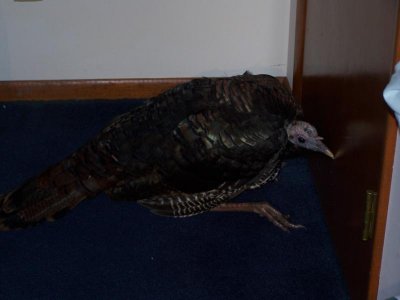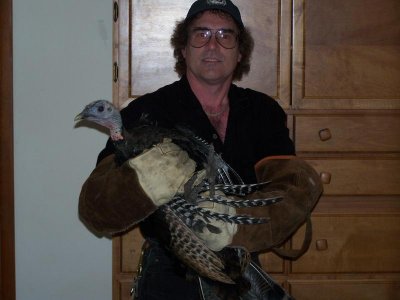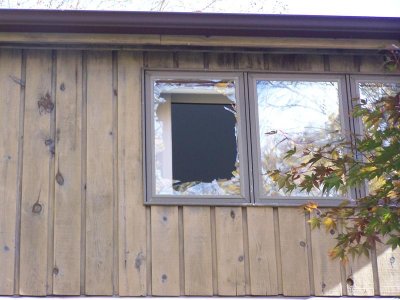I got a couple responses in the thread " NSXprimers what is your profession ? " http://www.nsxprime.com/forums/showthread.php?t=111740
So I figured I would start another thread if anyone is interested in what I do for a living without hijacking the original thread. I had an unusual call the other day and my local newspaper picked up on the story and put me on the front page.
Turkey in a tear takes out window
By Robert Miller
Staff Writer
Article Last Updated: 10/24/2008 10:32:39 PM EDT
RIDGEFIELD CT --DANBURY NEWS-TIMES
When an irresistible force, such as a flying turkey, meets an old, immovable object, like a double-paned window, you can bet as sure as you live that something's gotta give.
So Sandy Campbell learned last week.
Campbell, of Wilton Road East, heard a crash at his house. That's the sound of a tree limb smashing through a window, he thought.
"I checked the yard to see if a tree fell down," he said.
With all trees standing tall, he made sure his furnace hadn't backfired. He then went upstairs to check on the bedrooms. In one, he found the shards of a double-paned window scattered like fallen confetti, the window screen torn, the shade askew.
And lying on the floor, on its back, was a discombobulated wild turkey trying to get is bearings.
"It was trying to get its legs underneath it," he said. "I couldn't believe it."
Campbell called Craig Lewis, of Aardvark Animal Control in Danbury. By the time he arrived, the turkey was right side up and pacing the room, looking for an exit.
Lewis first tried to net the bird, only to find his net wasn't big enough. Then he donned heavy leather gloves, cornered the bird, and quickly snatched it up.
"It's a first time for me," Lewis said.
Such collisions are rare, but not unheard of, said Howard Kilpatrick, a wildlife biologist with the state Department of Environmental Protection.
"We occasionally get a report of a turkey or a grouse breaking a window,'' Kilpatrick said, however, it's not surprising the turkey crashed the window, rather than bouncing off.
The birds can weigh between 10 to 25 pounds, he said. When they go into their warp-speed glides, they can fly as fast as 55 mph.
"It's a heavy object moving very fast," he said.
And Lewis said, they've got a very heavy layer of black feathers as armor.
"That why they tell hunters to aim at their head and neck only,'' Lewis said.
That there aren't more collisions like the one at Campbell's house is due, in large part, to the strutting nature of turkeys. They're infrequent fliers.
"They fly to their roosts at night,'' Kilpatrick said. "They fly off to escape a predator, or to get over a big object. But typically, when you see them, they're walking.''
And, Kilpatrick said, birds can have a hard time distinguishing a window from the air in front of them. But most window-bird collisions involve small songbirds, not large fowls.
At Campbell's house, Lewis just took the turkey outside and let go.
"She took off,'' Lewis said.
And Campbell? With no Thanksgiving bird in hand, what did he come away with?
"I have a mess to clean up,'' he said.
Contact Robert Miller
at [email protected]
or at (203) 731-3345
Wild turkey Wild turkey (Meleagris gallopavo) Adult males, or toms, weigh between 15 and 25 pounds and stand 48 inches tall. Adult females, or hens, weigh between 8 and 12 pounds and stand 36 inches tall. Toms have dark iridescent feathers and a fleshy red, white and blue head. Colors on the head grow brighter in mating season. Toms also have spurs (up to 1.5 inches in length) on their legs, and a hair-like beard (up to 12 inches long) protruding from their breast. Hens have light brown feathers and a pale blue head. They lack spurs. A few have a beard. Live in hardwood forests and open fields. Diet includes acorns and other nuts, fruit, corn, seeds and invertebrates. Young turkeys feed more on insects. Abundant in Connecticut when the first settlers arrived. Eliminated by early 1800s. Between 1975 and 1992, 356 wild turkeys were released at 18 sites throughout the state. Wild turkeys are now found in all 169 towns in state. Source: Connecticut Department of Environmental Protection
So I figured I would start another thread if anyone is interested in what I do for a living without hijacking the original thread. I had an unusual call the other day and my local newspaper picked up on the story and put me on the front page.
Turkey in a tear takes out window
By Robert Miller
Staff Writer
Article Last Updated: 10/24/2008 10:32:39 PM EDT
RIDGEFIELD CT --DANBURY NEWS-TIMES
When an irresistible force, such as a flying turkey, meets an old, immovable object, like a double-paned window, you can bet as sure as you live that something's gotta give.
So Sandy Campbell learned last week.
Campbell, of Wilton Road East, heard a crash at his house. That's the sound of a tree limb smashing through a window, he thought.
"I checked the yard to see if a tree fell down," he said.
With all trees standing tall, he made sure his furnace hadn't backfired. He then went upstairs to check on the bedrooms. In one, he found the shards of a double-paned window scattered like fallen confetti, the window screen torn, the shade askew.
And lying on the floor, on its back, was a discombobulated wild turkey trying to get is bearings.
"It was trying to get its legs underneath it," he said. "I couldn't believe it."
Campbell called Craig Lewis, of Aardvark Animal Control in Danbury. By the time he arrived, the turkey was right side up and pacing the room, looking for an exit.
Lewis first tried to net the bird, only to find his net wasn't big enough. Then he donned heavy leather gloves, cornered the bird, and quickly snatched it up.
"It's a first time for me," Lewis said.
Such collisions are rare, but not unheard of, said Howard Kilpatrick, a wildlife biologist with the state Department of Environmental Protection.
"We occasionally get a report of a turkey or a grouse breaking a window,'' Kilpatrick said, however, it's not surprising the turkey crashed the window, rather than bouncing off.
The birds can weigh between 10 to 25 pounds, he said. When they go into their warp-speed glides, they can fly as fast as 55 mph.
"It's a heavy object moving very fast," he said.
And Lewis said, they've got a very heavy layer of black feathers as armor.
"That why they tell hunters to aim at their head and neck only,'' Lewis said.
That there aren't more collisions like the one at Campbell's house is due, in large part, to the strutting nature of turkeys. They're infrequent fliers.
"They fly to their roosts at night,'' Kilpatrick said. "They fly off to escape a predator, or to get over a big object. But typically, when you see them, they're walking.''
And, Kilpatrick said, birds can have a hard time distinguishing a window from the air in front of them. But most window-bird collisions involve small songbirds, not large fowls.
At Campbell's house, Lewis just took the turkey outside and let go.
"She took off,'' Lewis said.
And Campbell? With no Thanksgiving bird in hand, what did he come away with?
"I have a mess to clean up,'' he said.
Contact Robert Miller
at [email protected]
or at (203) 731-3345
Wild turkey Wild turkey (Meleagris gallopavo) Adult males, or toms, weigh between 15 and 25 pounds and stand 48 inches tall. Adult females, or hens, weigh between 8 and 12 pounds and stand 36 inches tall. Toms have dark iridescent feathers and a fleshy red, white and blue head. Colors on the head grow brighter in mating season. Toms also have spurs (up to 1.5 inches in length) on their legs, and a hair-like beard (up to 12 inches long) protruding from their breast. Hens have light brown feathers and a pale blue head. They lack spurs. A few have a beard. Live in hardwood forests and open fields. Diet includes acorns and other nuts, fruit, corn, seeds and invertebrates. Young turkeys feed more on insects. Abundant in Connecticut when the first settlers arrived. Eliminated by early 1800s. Between 1975 and 1992, 356 wild turkeys were released at 18 sites throughout the state. Wild turkeys are now found in all 169 towns in state. Source: Connecticut Department of Environmental Protection






